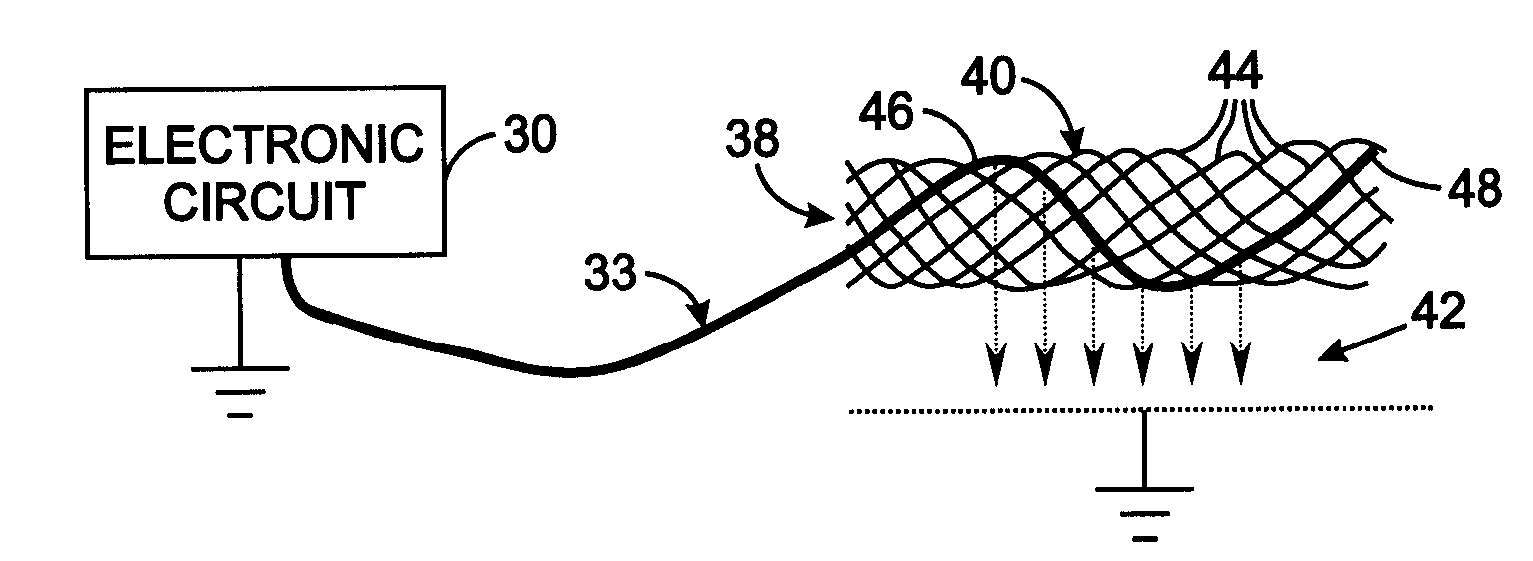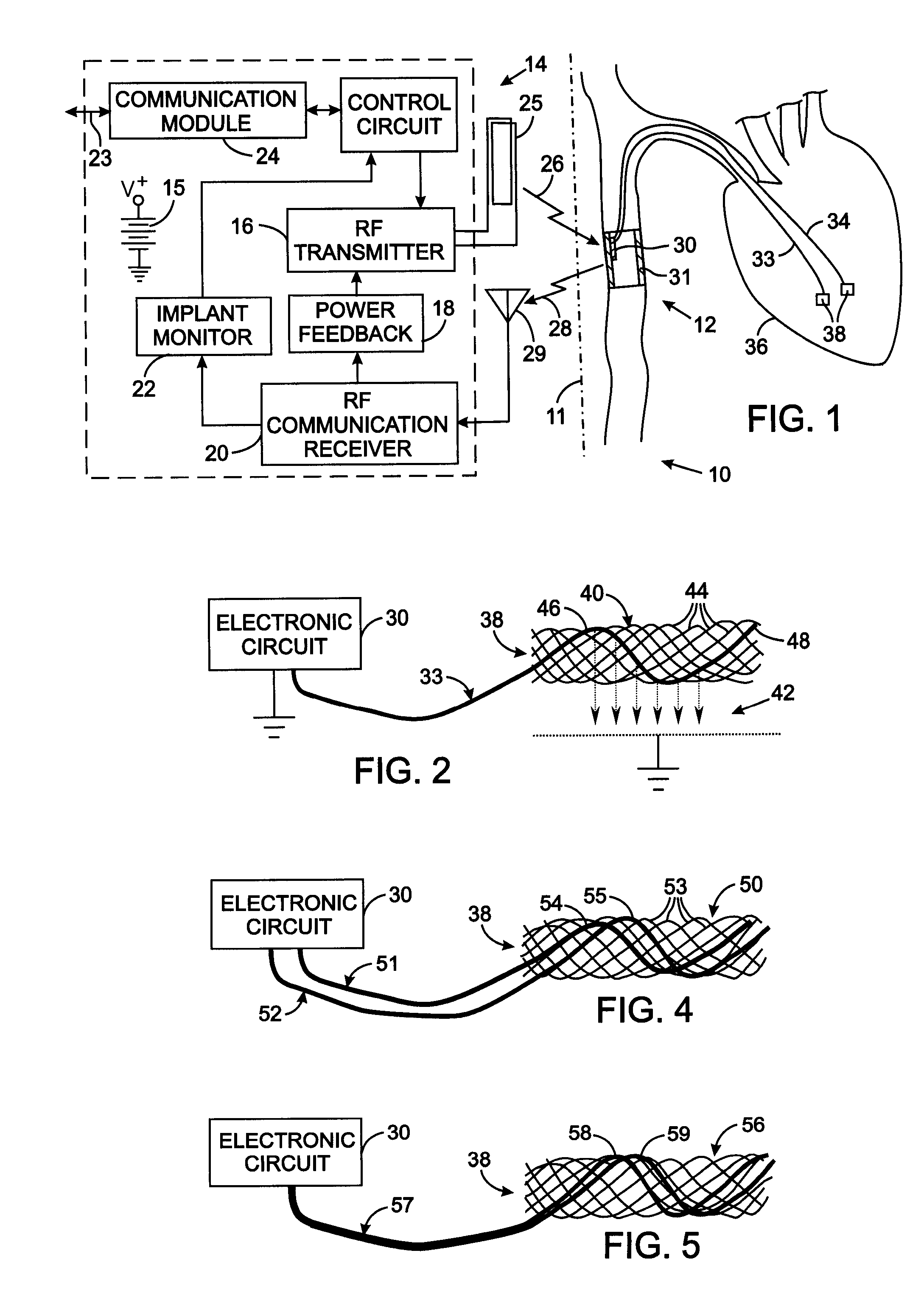Intravascular Electronics Carrier Electrode for a Transvascular Tissue Stimulation System
a tissue stimulation system and transvascular technology, applied in electrotherapy, heart stimulators, therapy, etc., can solve the problems of limited flexibility of the electrode/carrier assembly, potential apparatus failure,
- Summary
- Abstract
- Description
- Claims
- Application Information
AI Technical Summary
Benefits of technology
Problems solved by technology
Method used
Image
Examples
first embodiment
[0028]FIG. 2 illustrates the details of the electrode assembly 38 comprising an electrode carrier 40 to which an electrode lead 33 from the electronic circuit 30 connects. A mesh-type electrode carrier 40 can be employed which is similar to stents commonly used to enlarge constricted blood vessels. That type of carrier comprises a plurality of wires formed to have a memory defining a tubular shape or envelope. Those wires may be heat-treated platinum, Nitinol, a Nitinol alloy wire, stainless steel, plastic wires or other materials. Plastic or substantially nonmetallic wires may be loaded with a radiopaque substance which provides visibility with conventional fluoroscopy. A catheter assembly is used to implant the components of the medical device 12 in the animal's circulatory system. The electrode carrier 40 has a shape memory so that it normally assumes an expanded tubular configuration when unconfined, but is capable of assuming a collapsed configuration when disposed and confined...
second embodiment
[0032] In the electrode assembly 38 shown in FIG. 4, a pair of electrode leads 51 and 52 extend from the stimulator electronic circuit 30 to an electrode carrier 50 that has the same structure as electrode carrier 40 previously described. However, the stands 53 of the electrode carrier 50 do not have electrically conductive surfaces, i.e. the strands either are formed of non-conductive material or have a non-conductive surface coating. Bare conductors 54 and 55 portions of the two electrode leads 51 and 52, respectively, are interwoven into the stands of the electrode carrier 50. The bare conductors 54 and 55 are arranged so that they do not contact each other. Alternatively, only a small section of each electrode leads 51 and 52 in the electrode carrier 50 have an exposed conductor with those portions being spaced apart longitudinally along the electrode carrier 50. An electrical circuit is completed between the bare conductors 54 and 55 by the adjacent animal tissue, thereby provi...
third embodiment
[0033] With reference to FIG. 5, the electrode assembly 38 comprises an mesh-type electrode carrier 56 that has electrically non-conducting exterior surfaces similar the electrode carrier 50. A single electrode lead 57 extends from the stimulator electronic circuit 30 and has two electrically insulated conductors 58 and 59 encased in an insulating outer sheath. The two electrically insulated conductors 58 and 59 emerge from the outer sheath at the electrode carrier 50 and have their individual outer insulations removed from portions that are woven through the mesh of the electrode carrier 56. The exposed portions of each conductor are electrically separated from each other.
[0034] The design of a medical device that provides a reliable connection of an electrode to the conductor of the lead and to the electrode carrier requires configurations that are customized to the specific application of that device in the animal's body. FIGS. 6-8 show three exemplary configurations for such spe...
PUM
 Login to View More
Login to View More Abstract
Description
Claims
Application Information
 Login to View More
Login to View More - R&D
- Intellectual Property
- Life Sciences
- Materials
- Tech Scout
- Unparalleled Data Quality
- Higher Quality Content
- 60% Fewer Hallucinations
Browse by: Latest US Patents, China's latest patents, Technical Efficacy Thesaurus, Application Domain, Technology Topic, Popular Technical Reports.
© 2025 PatSnap. All rights reserved.Legal|Privacy policy|Modern Slavery Act Transparency Statement|Sitemap|About US| Contact US: help@patsnap.com



